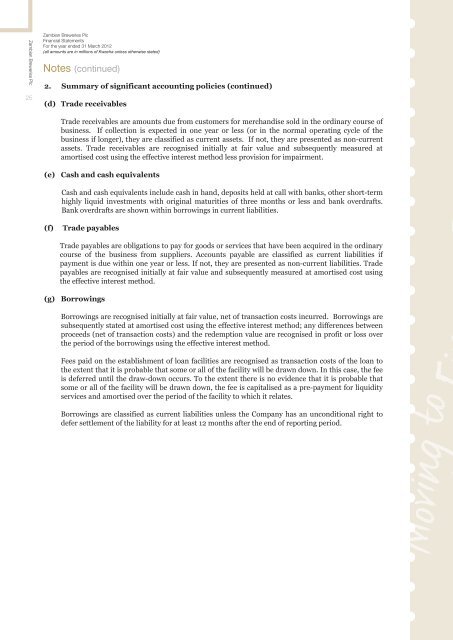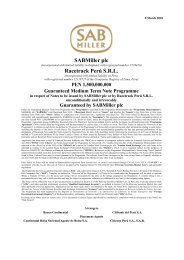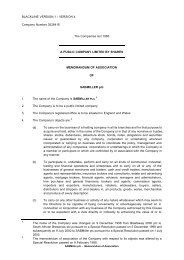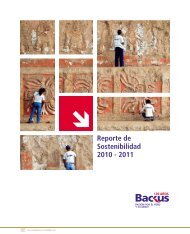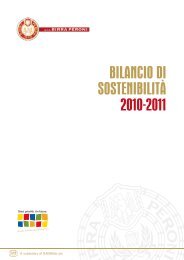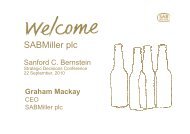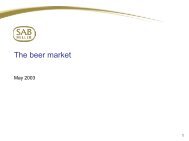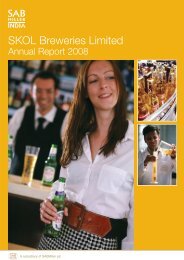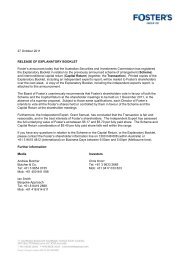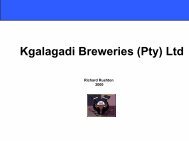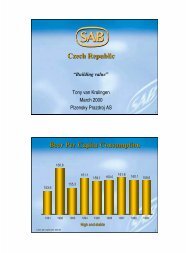Zambian Breweries Annual Report - Released June 2012 - SABMiller
Zambian Breweries Annual Report - Released June 2012 - SABMiller
Zambian Breweries Annual Report - Released June 2012 - SABMiller
Create successful ePaper yourself
Turn your PDF publications into a flip-book with our unique Google optimized e-Paper software.
<strong>Zambian</strong> <strong>Breweries</strong> Plc<br />
25<br />
<strong>Zambian</strong> <strong>Breweries</strong> Plc<br />
Financial Statements<br />
For the year ended 31 March <strong>2012</strong><br />
(all amounts are in millions of Kwacha unless otherwise stated)<br />
Notes (continued)<br />
2. Summary of significant accounting policies (continued)<br />
(d) Trade receivables<br />
Trade receivables are amounts due from customers for merchandise sold in the ordinary course of<br />
business. If collection is expected in one year or less (or in the normal operating cycle of the<br />
business if longer), they are classified as current assets. If not, they are presented as non-current<br />
assets. Trade receivables are recognised initially at fair value and subsequently measured at<br />
amortised cost using the effective interest method less provision for impairment.<br />
(e)<br />
Cash and cash equivalents<br />
Cash and cash equivalents include cash in hand, deposits held at call with banks, other short-term<br />
highly liquid investments with original maturities of three months or less and bank overdrafts.<br />
Bank overdrafts are shown within borrowings in current liabilities.<br />
(f)<br />
Trade payables<br />
Trade payables are obligations to pay for goods or services that have been acquired in the ordinary<br />
course of the business from suppliers. Accounts payable are classified as current liabilities if<br />
payment is due within one year or less. If not, they are presented as non-current liabilities. Trade<br />
payables are recognised initially at fair value and subsequently measured at amortised cost using<br />
the effective interest method.<br />
(g)<br />
Borrowings<br />
Borrowings are recognised initially at fair value, net of transaction costs incurred. Borrowings are<br />
subsequently stated at amortised cost using the effective interest method; any differences between<br />
proceeds (net of transaction costs) and the redemption value are recognised in profit or loss over<br />
the period of the borrowings using the effective interest method.<br />
Fees paid on the establishment of loan facilities are recognised as transaction costs of the loan to<br />
the extent that it is probable that some or all of the facility will be drawn down. In this case, the fee<br />
is deferred until the draw-down occurs. To the extent there is no evidence that it is probable that<br />
some or all of the facility will be drawn down, the fee is capitalised as a pre-payment for liquidity<br />
services and amortised over the period of the facility to which it relates.<br />
Borrowings are classified as current liabilities unless the Company has an unconditional right to<br />
defer settlement of the liability for at least 12 months after the end of reporting period.<br />
14


